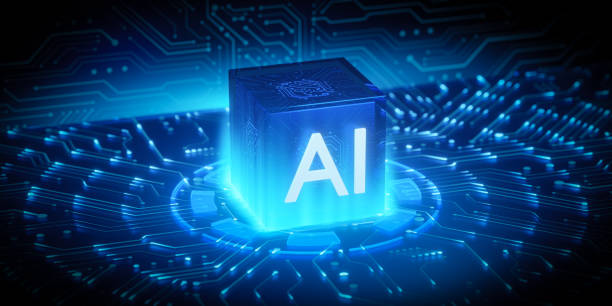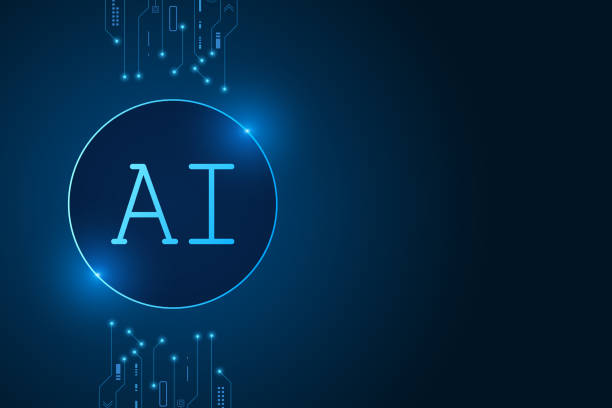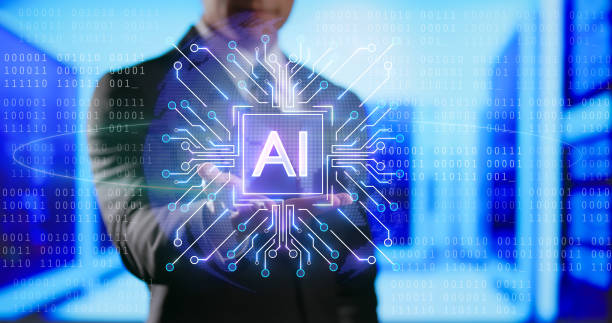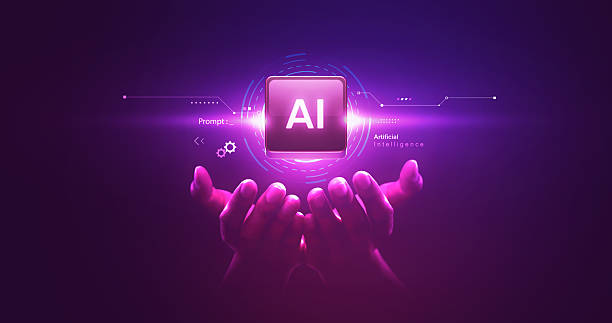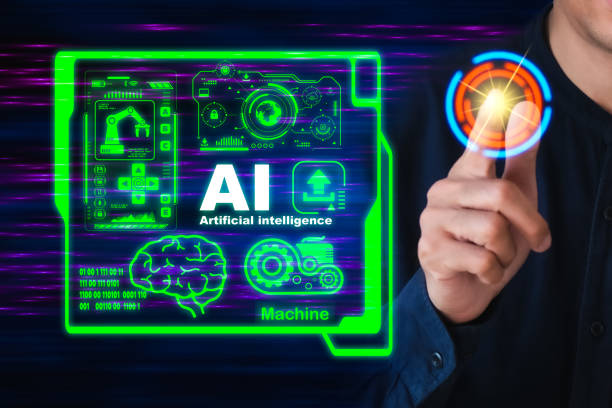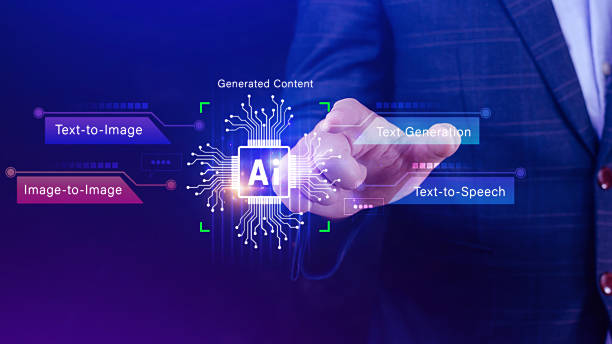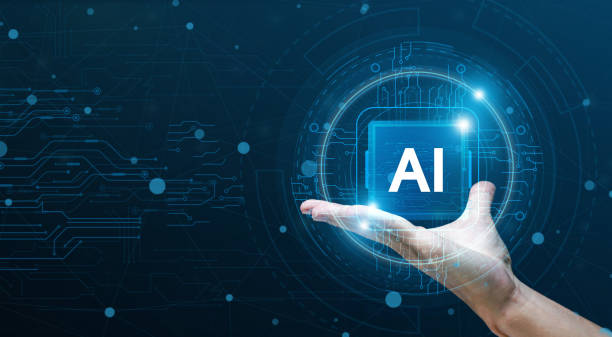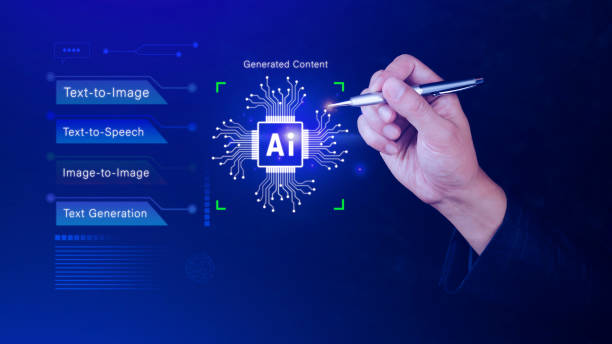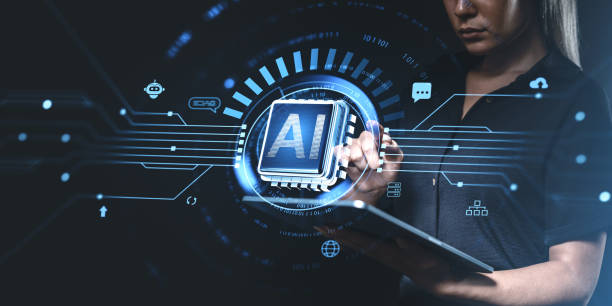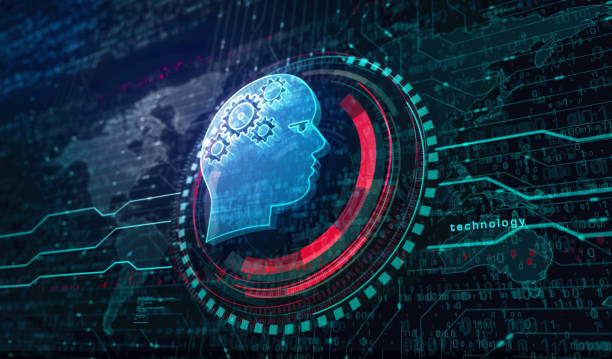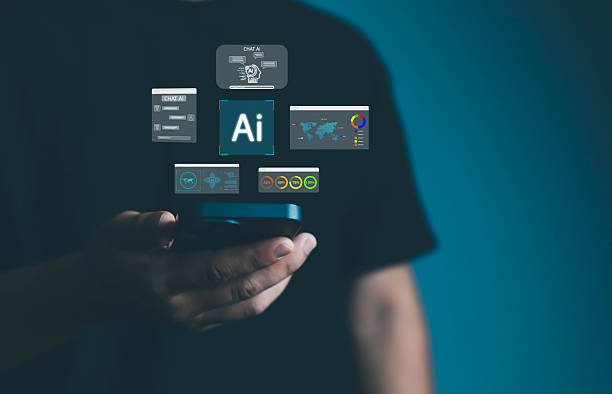What is an Artificial Intelligence Robot and How Does it Work?
#Artificial Intelligence Robot is a combination of two separate fields: robotics and artificial intelligence.
Simply put, robots are machines capable of performing automated tasks, while artificial intelligence allows machines to think, learn, and make decisions.
When these two fields are combined, the result is an intelligent robot that can perform tasks that were previously only possible by humans.
These robots use sensors to receive environmental information, process this information using artificial intelligence algorithms, and act accordingly.
For example, an AI-powered warehouse robot can automatically find its way through the warehouse, identify goods, and move them to the desired location.
This robot can continuously improve its performance and become more efficient using Computer Vision and Machine Learning.
Artificial intelligence plays a key role in decision-making, planning, and problem-solving in these robots.
In general, artificial intelligence robots exist in three different levels of complexity.
The first level consists of simple robots that can only perform pre-defined tasks.
The second level consists of robots that can learn from their experiences and improve their performance.
And the third level consists of robots that can make decisions independently and even be creative.
Artificial intelligence robots have a great potential to change our lives and will play a more important role in various industries in the future.
Did you know that 94% of first impressions of a company are related to its website design?
Rasawap helps you make the best first impression by providing professional corporate website design services.
✅ Create a professional and reliable image of your brand
✅ Attract potential customers more easily and improve online ranking
⚡ Get a free corporate website design consultation
Widespread Applications of Artificial Intelligence Robots in Various Industries
Artificial intelligence robots are rapidly penetrating various industries and leaving significant impacts.
In the manufacturing industry, these robots are used to perform repetitive, dangerous, and precise tasks such as welding, painting, and assembling parts.
This leads to increased productivity, reduced costs, and improved product quality.
In the field of healthcare, surgeon robots can perform complex surgeries with high precision, nurse robots can help patients, and pharmacist robots can distribute medications accurately and quickly.
These applications improve the quality of healthcare and reduce medical errors.
In the service sector, chatbot robots can answer customer questions, waiter robots can serve food and drinks, and guard robots can provide environmental security.
This leads to improved customer experience, reduced costs, and increased efficiency.
Artificial intelligence robots also have various applications in the fields of education, agriculture, space exploration, and many other areas.
For example, in agriculture, robots can automatically plow the land, sow seeds, irrigate, and harvest crops.
This leads to increased productivity, reduced costs, and optimal use of natural resources.
In general, the applications of artificial intelligence robots are very wide-ranging, and as technology advances, these applications become more and more numerous.
In short, artificial intelligence robots with their automation, learning, and decision-making capabilities, make it possible to improve efficiency, reduce costs, and increase quality in various industries.
From production lines to healthcare, customer service, and agriculture, these robots play an important role in transforming and optimizing processes, and their role is expected to become more prominent in the future with further technological development.
Advantages and Disadvantages of Using Artificial Intelligence Robots
The use of artificial intelligence robots has many advantages.
Increased productivity, reduced costs, improved quality, performing dangerous and repetitive tasks, and providing 24-hour service are among these advantages.
However, along with these advantages, there are also disadvantages.
These disadvantages include the loss of human jobs, the need for high initial investment, the complexity of the technology, and the ethical issues related to robot decision-making.
For example, if a surgeon robot makes a wrong decision during surgery, who will be responsible? Or if an artificial intelligence robot automatically decides to fire employees, is this decision fair?
To benefit from the advantages of artificial intelligence robots and reduce its disadvantages, appropriate policies are needed in the areas of education, employment, and ethics.
Workers should be helped to acquire the skills needed to work with robots and supported so that they can find new jobs if they lose their jobs.
Also, strict ethical standards should be developed for the design and use of artificial intelligence robots to prevent abuse of this technology.
It is also essential to consider the broader economic and social impacts of replacing human labor with robots.
Click here to preview your posts with PRO themes ››
It must be ensured that technological advances do not lead to increased inequality and the creation of a class divide.
For this purpose, governments and international organizations should work together to develop policies that ensure that the benefits of artificial intelligence robots are fairly distributed among all members of society.
| Advantages |
|---|
| Increased productivity |
| Reduced costs |
| Improved quality |
| Performing dangerous tasks |
| Providing 24-hour service |
| Disadvantages |
|---|
| Loss of human jobs |
| Need for high investment |
| Technology complexity |
| Ethical issues |
Challenges of Developing and Implementing Artificial Intelligence Robots
The development and implementation of artificial intelligence robots faces numerous challenges.
One of the most important challenges is the lack of sufficient and high-quality training data.
Artificial intelligence robots need a large amount of data to learn and improve their performance.
If the training data is incomplete, incorrect, or unbalanced, the robot cannot function properly.
Another challenge is the complexity of artificial intelligence algorithms.
Designing and implementing algorithms that can effectively process information and make correct decisions is difficult.
There are also challenges in integrating artificial intelligence robots with existing systems, ensuring the security of robots against cyber attacks, and ensuring the reliability of robots in various conditions.
In addition, the discussion of ethics and accountability in the development of artificial intelligence robots is of particular importance.
It must be ensured that robots are designed and programmed to act in the best interests of humans and respect human rights and values.
Also, appropriate mechanisms should be created to address public questions and concerns about the use of artificial intelligence robots.
In short, the challenges of developing and implementing artificial intelligence robots include the lack of high-quality training data, algorithm complexity, integration issues, cybersecurity, reliability, and ethical and accountability issues.
To overcome these challenges, collaboration between researchers, industrialists, policymakers, and civil society is needed.
Does your current corporate website reflect the credibility and power of your brand as it should? Rasawap solves this challenge for you with professional corporate website design.
✅ Increase visitor credibility and trust
✅ Targeted acquisition of more customers
⚡ Click to get a free consultation!
What Will the Future of Artificial Intelligence Robots Be?
The future of artificial intelligence robots is very bright and full of potential.
As technology advances, these robots are expected to be able to perform more complex tasks and play a more prominent role in our lives.
In the future, robots will likely be able to learn independently, be creative, and communicate with humans more naturally.
Also, robots are expected to be used in new areas such as space, deep sea, and hazardous environments.
However, the development of artificial intelligence robots requires attention to ethical and social issues.
It must be ensured that this technology is used for the benefit of all members of society and does not lead to increased inequality and the elimination of human rights.
Also, appropriate mechanisms should be created to control and monitor robots to prevent their abuse.
Ultimately, the future of artificial intelligence robots depends on our choices.
If we can develop this technology responsibly and with foresight, we can benefit from its advantages and create a better world for ourselves and future generations.
The Impact of Artificial Intelligence Robots on the Labor Market
The impact of artificial intelligence robots on the labor market is a controversial topic.
On the one hand, these robots can increase productivity by automating repetitive and tedious tasks and create new jobs.
On the other hand, these robots can lead to job losses and increased unemployment by replacing human labor.
It seems that the impact of artificial intelligence robots on the labor market depends on the type of job, skill level, and the speed of technological progress.
Jobs that require low skills and performing repetitive tasks are more at risk of being replaced by robots.
In contrast, jobs that require high skills, creativity, and human interaction are less at risk.
To reduce the negative impact of artificial intelligence robots on the labor market, it is necessary to invest in education and skills training so that workers can acquire the skills needed to work with robots and be employed in new jobs.
In addition, governments and international organizations should develop policies that protect workers from the negative effects of automation and create new job opportunities.
Click here to preview your posts with PRO themes ››
These policies could include creating social safety nets, providing free training, and creating incentives for employers to hire workers.
Case Studies of Artificial Intelligence Robots in Various Industries
To better understand the application of artificial intelligence robots, one can look at case studies of them in various industries.
In the manufacturing industry, artificial intelligence robots are used for tasks such as quality inspection, welding, and assembling parts.
These robots can improve product quality and reduce production costs with high accuracy and speed.
For example, Tesla uses artificial intelligence robots on its production lines to assemble electric vehicles.
These robots are able to assemble different parts of the car with high speed and accuracy and ensure the final product quality.
In the field of healthcare, artificial intelligence robots are used to perform surgeries, diagnose diseases, and provide healthcare.
These robots can perform complex surgeries with high precision and minimal invasion and reduce the risk of side effects.
For example, the Da Vinci robot is a surgical robot that is used by doctors to perform high-precision surgeries.
| Industry | Application | Example |
|---|---|---|
| Manufacturing | Quality inspection, Welding, Assembly | Tesla |
| Healthcare | Surgery, Diagnosis, Healthcare | Da Vinci Robot |
In the service sector, artificial intelligence robots are used to provide customer service, answer questions, and perform financial transactions.
These robots can provide 24-hour service and meet customer needs.
For example, many banks use artificial intelligence chatbots to answer customer questions and perform simple transactions.
Data Security and Protection in Artificial Intelligence Robots
Data security and protection in artificial intelligence robots is of paramount importance.
Artificial intelligence robots need a large amount of data to learn and perform their tasks.
If this data is not properly protected, it may be at risk of theft, manipulation, or misuse.
For example, if users’ personal data is stolen by an artificial intelligence robot, this information may be used for illegal purposes.
To ensure data security and protection in artificial intelligence robots, it is necessary to use strong encryption methods, precise access control, and continuous monitoring.
Also, it must be ensured that robots are designed and programmed to use data responsibly and respect users’ privacy.
In addition, appropriate mechanisms should be created for reporting and handling data breaches so that an accident can be responded to quickly and damage can be minimized.
In short, data security and protection in artificial intelligence robots is of vital importance and requires the use of strong security methods, responsible robot design, and the creation of accountability mechanisms.
Are you lagging behind in competition with large online stores?
Rasawap makes your business online and increases your market share with professional online store design!
✅ Increase brand credibility and customer trust
✅ Easy shopping experience leading to more sales
⚡ Take action now to get free website design consultation!
Ethical Considerations in the Design and Use of Artificial Intelligence Robots
The design and use of artificial intelligence robots is accompanied by numerous ethical considerations.
One of the most important considerations is to ensure that robots are designed to act in the best interests of humans and respect human rights and values.
For example, if an artificial intelligence robot is used to make decisions about the allocation of limited resources, it must be ensured that this decision-making is based on the principles of justice and fairness.
Another ethical consideration is accountability for the decisions and actions of artificial intelligence robots.
If a robot causes damage while performing its tasks, who will be responsible? The robot designer, the robot user, or the robot itself? To answer these questions, appropriate legal and ethical frameworks need to be developed.
Also, it must be ensured that robots are designed to be controllable and monitorable and can be stopped if necessary.
In short, the design and use of artificial intelligence robots requires attention to numerous ethical considerations, including ensuring alignment with human interests, respecting human rights and values, accountability for robot decisions and actions, and the ability to control and monitor them.
How to Choose the Right Artificial Intelligence Robot for Your Business?
Choosing a suitable artificial intelligence robot for your business requires a thorough review of your needs, goals, and budget.
First, you need to specify what tasks you want to assign to the robot and what you expect from its performance.
Then you need to do enough research and review the different robots available in the market.
Click here to preview your posts with PRO themes ››
When reviewing robots, pay attention to factors such as capabilities, price, ease of use, technical support, and security.
Also, before buying a robot, be sure to test it and make sure it works in real conditions.
If possible, get help from artificial intelligence experts to guide you in choosing the right robot.
After choosing a robot, you need to have a detailed plan for implementing and training your staff so that you can fully benefit from the robot.
Finally, remember that artificial intelligence robots are just a tool, and your success depends on how you use them.
To start the selection process, make a list of your business needs.
This list should include tasks that are currently performed by human labor and can be improved by using an artificial intelligence robot.
Then, based on your budget and available resources, select robots that match your needs.
Finally, before making a final decision, consult with other businesses that use similar robots and use their experiences.
Frequently Asked Questions
| Row | Question | Answer |
|---|---|---|
| 1 | What is an artificial intelligence robot? | An artificial intelligence robot is a machine that can understand, reason, learn, and solve problems and can perform complex tasks with relative autonomy. |
| 2 | What are the most important applications of artificial intelligence robots? | The main applications include industrial production, customer service (chatbots), medicine and surgery, self-driving transport, space exploration, and military affairs. |
| 3 | What is the main difference between an artificial intelligence robot and a regular robot? | A regular robot only follows programmed instructions, while an artificial intelligence robot can learn from data, make decisions, and adapt to new environments. |
| 4 | How do artificial intelligence robots learn? | They identify patterns and improve their performance through machine learning algorithms (such as deep learning, reinforcement learning) and processing vast amounts of data. |
| 5 | Can artificial intelligence robots have emotions? | Currently, artificial intelligence robots do not have real emotions in the human sense. They can mimic or recognize emotions, but they do not have an understanding and experience of them. |
| 6 | What are the current limitations of artificial intelligence robots? | Limitations include the need for large amounts of data, the inability to understand abstract concepts, the lack of real creativity, ethical issues, and the challenges of generalizability in new environments. |
| 7 | What is the role of artificial intelligence in the development of Humanoid robots? | Artificial intelligence helps humanoid robots walk, maintain balance, understand their surroundings, interact with humans, and perform complex tasks. |
| 8 | How is the future of artificial intelligence robots predicted? | It is predicted that artificial intelligence robots will be smarter, more autonomous, and able to perform more complex tasks in everyday life and industry, and their interaction with humans will increase. |
| 9 | Can artificial intelligence robots replace all human jobs? | It is unlikely that all human jobs will be replaced. Robots take over many repetitive and dangerous tasks, but jobs that require creativity, empathy, and ethical judgment will remain. |
| 10 | What ethical and social challenges are raised by the expansion of artificial intelligence robots? | Challenges include issues related to privacy, data security, ethical decision-making by robots, the impact on employment, and accountability in the event of an error. |
And other services of Rasa Web Advertising Agency in the field of advertising
Intelligent Content Strategy: A novel service to increase campaign management through dedicated programming.
Intelligent Brand Identity: A professional solution for digital branding with a focus on optimizing key pages.
Intelligent Data Analysis: A novel service to increase customer acquisition through marketing automation.
Intelligent Brand Identity: Designed for businesses looking to attract customers through marketing automation.
Intelligent Google Ads: A combination of creativity and technology to increase click-through rates through dedicated programming.
And more than hundreds of other services in the field of internet advertising, advertising consulting, and organizational solutions
Internet advertising | Advertising strategy | Reportage advertising
Sources
Artificial intelligence chat robots: a transformation in online interactions
, Artificial intelligence robots: A look at the future of artificial intelligence
, What is Chat GPT? and its applications
, What is an artificial intelligence robot? Application, types, and benefits
? To promote your business in the digital space, Rasa Web Digital Marketing Agency is your reliable partner. With our services, from responsive website design to SEO optimization and social media management, your path to success will be smoother.
📍 Tehran, Mirdamad Street, next to the Central Bank, South Kazerun Alley, Ramin Alley No. 6

